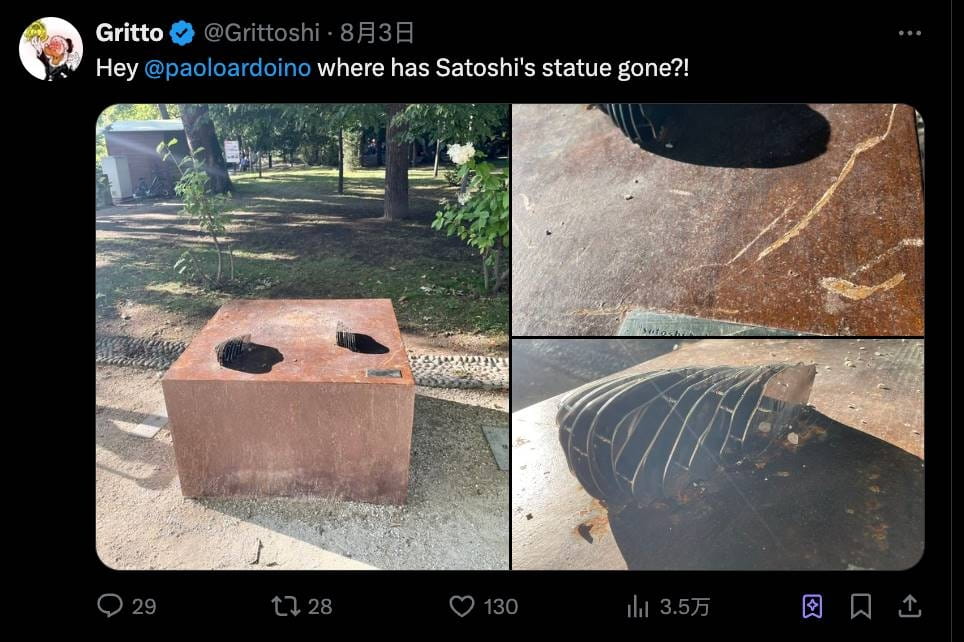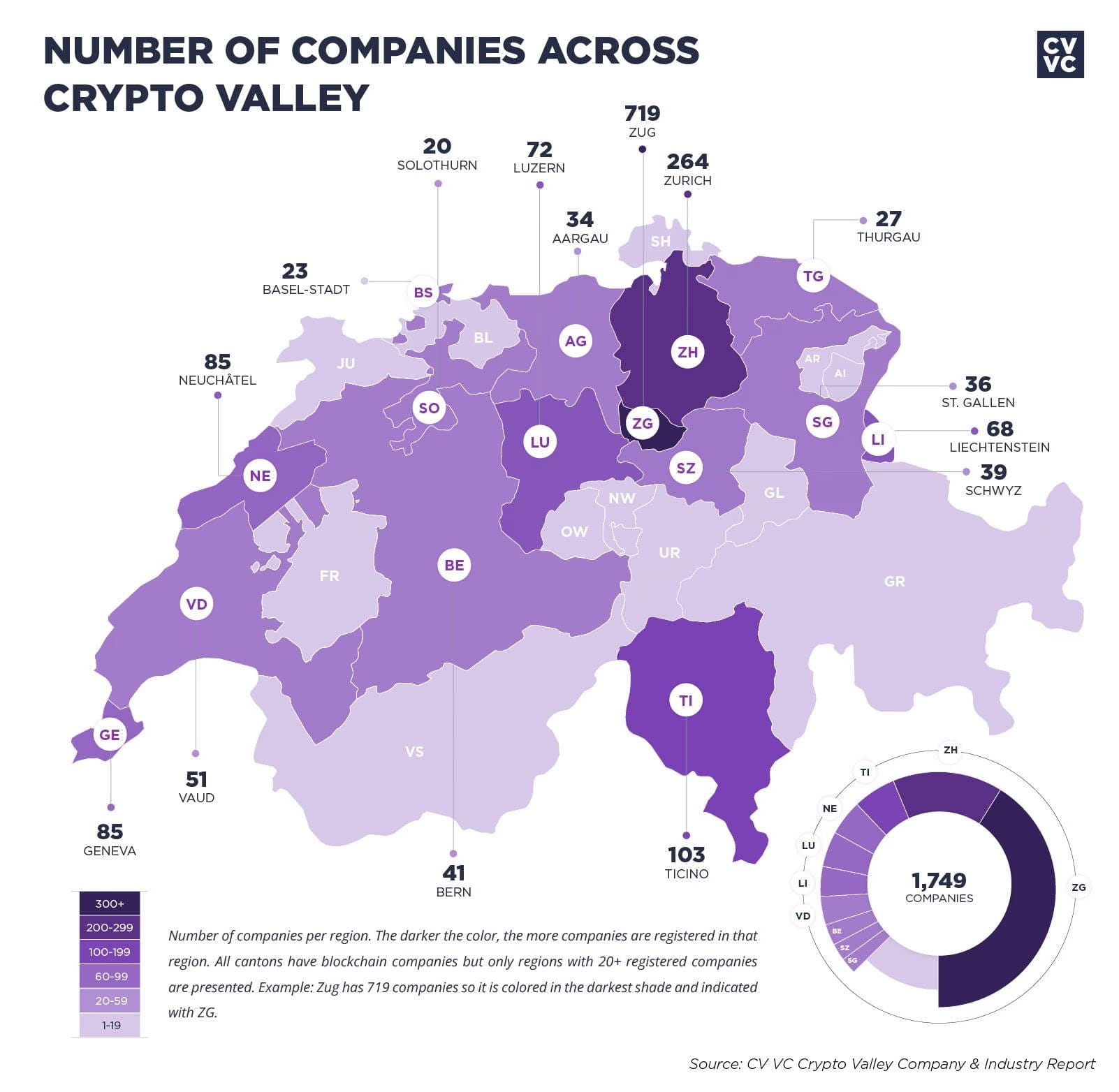Written by: David, Deep Tide TechFlow

On the morning of August 3, in Lugano, Switzerland, municipal workers salvaged several pieces of stainless steel from the lake.
Just a few hours ago, these pieces were part of a complete statue of Satoshi Nakamoto. A city's tribute to the creator of Bitcoin is now reduced to scrap metal at the bottom of the lake.
Twitter user @Grittoshi was the first to discover the statue's disappearance. He recalled that on the evening of August 1, Swiss National Day, the statue was still standing in Parco Ciani park. Nearby, young people were raising their glasses in celebration at an outdoor café.
A few hours later, this artwork, which took 21 months to design and was said to 'disappear' when viewed from the front, really did disappear—in a way no one anticipated.

Satoshigallery, an art group dedicated to erecting statues of Satoshi Nakamoto in 21 cities around the world, quickly offered a reward of 0.1 Bitcoin on social media for clues.
However, the process of solving the case was unexpectedly simple.
It was also internet user @Grittoshi who theorized using 'Occam's Razor': the drunken revelers passing by the statue on National Day may have spontaneously decided to 'find some fun.' They couldn't have moved the statue far; the most likely scenario was to toss it into the nearby lake.
A few hours later, his guess was confirmed—a municipal worker really did pull a shattered Satoshi Nakamoto from the bottom of the lake.
No one has been caught, and perhaps no one ever will be. To the locals, this is likely just a prank by a group of drunk youths.
The statue was only secured to its base by two welding points and could be broken off by a few people working together. In a sense, this is more frustrating than a premeditated act of destruction: to the destroyers, this valuable statue was just a toy for drunken amusement.
The statue is indeed shattered. Satoshigallery posted on Twitter: "You can steal our symbol, but you can never steal our soul."
Satoshi Nakamoto is indeed the soul of the entire crypto industry, but not necessarily in Lugano, Switzerland.
Behind the bold declaration, last October, this statue was just unveiled at Lugano's most important blockchain conference, where the mayor personally endorsed it as a representation of the city's digital innovation spirit.
Less than a year later, it was thrown into the lake by the citizens.
As the Lugano city government ambitiously vowed to become 'the crypto capital of Europe,' there may exist a deep gap deeper than Lake Lugano between the government's enthusiastic embrace and the genuine attitude of the public in Switzerland, the world's most crypto-friendly country.
The statue can be salvaged, but what about trust?
Lugano Plan B: A crypto capital built with money?
In March 2022, when Bitcoin was still hovering around $40,000, Lugano's mayor Michele Foletti stood in the spotlight and announced an ambitious plan. Next to him was Paolo Ardoino, the chief technology officer of stablecoin giant Tether.
The 'Plan B' plan jointly announced by the two aims to make this small town of 60,000 in southern Switzerland the 'crypto capital of Europe.'

Plan B, as the name suggests, is an alternative plan. When the traditional financial system fails, cryptocurrency becomes that Plan B. But for Lugano, this name has another layer of meaning—when other Swiss cities are already far ahead in the crypto race, it needs a Plan B to overtake.
Two years have passed, and the report card looks quite impressive:
According to the data released by Tether, the Plan B forum in October 2024 set a record, attracting over 2,500 global participants. During the week of the forum, Lugano recorded 6,121 cryptocurrency transactions.
Nearly 100 merchants in the city accept Bitcoin and USDT payments, and 300 accept the city's token LVGA. Even the jerseys of the Lugano football club have the Bitcoin logo printed on them.
But a closer look at these numbers reveals a stark contrast.
What is the total amount of 6,121 transactions? $160,000. That means an average of $26 per transaction. This data is still too small.
"We chose to print the Bitcoin logo on the jerseys instead of Tether for educational purposes," Ardoino said in an interview. But local merchants privately complained that most customers still preferred to use cards or cash. Accepting crypto payments seemed more like complying with government requests than a business necessity.
More subtly, there is the relationship between Lugano and Tether. This world's largest stablecoin issuer is not only a major sponsor of Plan B but is also deeply involved in the city's digital transformation.
The question is, is it really wise to bet the city's crypto future on a commercial company, especially when that company is already fraught with controversy—the transparency of Tether's reserves remains the sword of Damocles in the crypto world.
The incident of the Satoshi Nakamoto statue being thrown into the lake seems to have become a kind of prophecy.
This reportedly expensive piece of art pursued visual effects in its design—appearing to 'disappear' from certain angles—yet overlooked the most basic safety considerations, being secured by only two welding points.
Is this emphasis on form over substance also a microcosm of the entire Plan B?
While the crypto ecosystem has naturally grown over many years within the community, Lugano chose a shortcut: paving the way with money and hyping through marketing. But just like the statue sunk at the bottom of the lake, a technological transplant without social soil may ultimately just be an expensive ornament.
Switzerland's crypto landscape, Lugano's misaligned competition
If Switzerland's crypto landscape is likened to a marathon, Lugano is undoubtedly the runner who starts the latest but runs the hardest.
Zug, a small town with a population of only 30,000, began its crypto journey as early as 2013. When entrepreneur Johann Gevers moved his company Monetas here, 'Crypto Valley' was just a beautiful vision borrowed from Silicon Valley. But by 2024, Zug had gathered 719 blockchain companies, accounting for 41% of Switzerland.

More importantly, Ethereum was born here—if Bitcoin is the Adam of the crypto world, Ethereum is Eve.
The numbers are cold, but they tell vastly different developmental paths. In Zug, 47% of financial services blockchain companies and 43% of infrastructure companies chose to settle here. This is not the result of government planning, but rather a natural selection of the market—low tax rates, loose regulation, and most crucially—a organically grown entrepreneurial ecosystem.
People working in blockchain companies in Zug likely live in the same community, have their children in the same schools, and discuss tech issues at the same bars on weekends.
In contrast, the Ticino region where Lugano is located has only 103 blockchain companies, but Lugano is unwilling to play a supporting role.
When Plan B was launched in 2022, their strategy was clear: since they could not replicate Zug's first-mover advantage, they would take a different path. Zug is a paradise for engineers, Geneva is the home ground for compliance experts, Zurich is the center of fintech, so what does Lugano want to become?
The answer is a testing ground for consumer applications.
Lugano chose a seemingly sexier path: allowing ordinary people to use cryptocurrency. However, in the two years since Plan B was launched, most merchants accepting Bitcoin payments have been more about performance than real demand.

The local McDonald's in Lugano accepts Bitcoin payments.
Source: PlanB.lugano
Even more awkward is the internal competition among Swiss cities. In 2023, Zug announced an increase in the cryptocurrency payment limit for taxes from 100,000 Swiss francs to 1.5 million Swiss francs—this is a real application scenario; the same year, Lugano also issued a blockchain bond of 100 million Swiss francs. However, while this seems innovative, what difference does it make to ordinary citizens compared to traditional bonds?
Lugano seems to want to complete in two years what Zug has achieved in ten.
But a crypto ecosystem is not about erecting a statue and calling it a day. It needs time to ferment, requires failed projects to serve as fertilizer, and demands genuine participation from the local community.
The throwing of the Satoshi Nakamoto statue into the lake may not be because the people of Lugano hate Bitcoin, but because they simply do not care.
Forcing a crypto agenda in a city lacking a crypto gene is like planting rice in a desert—it's not impossible, but the cost is too high and goes against the laws of nature.
Statue Metaphor
The night the Satoshi Nakamoto statue spent at the bottom of the lake may have been the most ironic moment of its existence. This artwork, designed to 'pay tribute to the spirit of decentralization,' ultimately required centralized municipal power to salvage.
When the Lugano government talks about the blockchain revolution, citizens have their own life priorities.
Those drunken youths who threw the statue into the lake on Swiss National Day are probably not opponents of cryptocurrency. They likely vandalized the statue simply because it happened to be there—a seemingly fun thing to do.
This indifference is scarier than hatred of cryptocurrency. Hatred at least shows some concern, while indifference means 'it doesn't matter.'
The deeper issue lies in the development model of 'embracing crypto' itself. Zug's success comes from ten years of natural growth, supported by an ecosystem built by entrepreneurs, investors, and tech geeks; while Lugano tries to replicate this process in two years through top-down administrative push.
It's a bit like trying to achieve the taste of slow-cooked stew in a microwave—it looks cooked, but the taste is off.
When the government changes, when budgets tighten, and when the next policy hotspot emerges, will the crypto-friendly Plan B still be a priority?
The statue can be re-welded, and even reinforced to be as solid as a rock, but once the crack of trust occurs, repairing it is far more difficult than imagined.
The young man who threw Satoshi into the lake is not a bad person, but pushing a crypto agenda in a city indifferent to cryptocurrency may not yield optimistic results.

